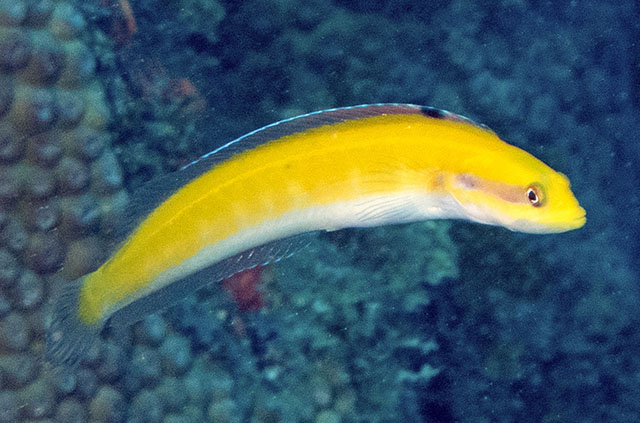| Chaenopsidae (Pike-, tube- and flagblennies) |
| 10 cm TL (male/unsexed) |
|
reef-associated; marine; depth range - 20 m |
| Western Atlantic: southern Florida, USA and the Bahamas to Central America. |
|
Dorsal soft rays (total): 11-18; Anal spines: 2-2. Species distinguished by: dorsal fin consisting of spines and 11 to 18 segmented dorsal-fin rays; total dorsal-fin elements 29 to 40; tip of lower jaw projecting beyond tip of upper jaw and without fleshy projection; no cirri on eye; top of head never spiny; one row of teeth on each palatine bone; a broad, dark longitudinal stripe or series of dark blotches extending from eye to caudal-fin base usually present. Common amongst Chaenopsids: small elongate fishes; largest species about 12 cm SL, most under 5 cm SL. Head usually with cirri or fleshy flaps on anterior nostrils, eyes, and sometimes laterally on nape; gill membranes continuous with each other across posteroventral surface of head. Each jaw with canine-like or incisor-like teeth anteriorly; teeth usually also present on vomer and often on palatines (roof of mouth). Dorsal-fin spines flexible, usually outnumbering the segmented soft rays, spinous and segmented-rayed portions forming a single, continuous fin; 2 flexible spines in anal fin; pelvic fins inserted anterior to position of pectoral fins, with 1 spine not visible externally and only 2 or 3 segmented (soft) rays; all fin rays, including caudal-fin rays, unbranched (simple). Lateral line absent. Scales absent (Ref.52855). |
| Lives in holes in coral and rock, but leaves burrow to swim freely in water column. Mimics the bluehead, Thalassoma bifasciatum, in order to get close to small fish and shrimps on which it preys. Also feeds on copepods (Ref. 5521). |
|
Least Concern (LC); Date assessed: 18 October 2007 Ref. (130435)
|
| harmless |
Source and more info: www.fishbase.org. For personal, classroom, and other internal use only. Not for publication.
